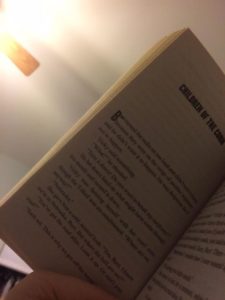by Jay Wilburn
The plan is to reread all of Stephen King’s works in the order that they were published. Richard Chizmar of Cemetery Dance had the vision. I’m doing it because I am a writer and I want to improve my long fiction. I think there is something to be learned through this challenge. As Richard Chizmar and Bev Vincent put up their posts on the official site, I will link those in the corresponding ones of mine on this blog.
Here is the link the Master List of all my #StephenKingRevisited posts.
We are looking at the short story collection Night Shift by Stephen King.
Here is my Before Night Shift post.
Here is Bev Vincent’s historic essay on the collection.
Here is Richard Chizmar’s thoughts on his reading.
Here is Brian Keene’s guest essay on the Night Shift.

Let’s take a look at the Night Shift …
I will strive to be spoiler free as much as possible dealing with specific examples in a general way, but I will be discussing content in these blog posts. So, you have been warned.
When I started this process, I was moving away from short stories and developing my longer fiction. I’ve written a novel or two. Since then, health has stepped in and my current novel in process is on hold as I prepare to go into surgery for a kidney transplant. Writers are always looking for excuses not to finish. I also began a new round of the A Story A Week Challenge. One short story every week for a year. The short story collections in #StephenKingRevisited take on new meaning again, I suppose.
Night Shift opens with a great essay. It discusses objectivity and demons in the path. With demons in the path, either “you whip them or they whip you.” The introduction talks about the “I always wanted to write” crowd. In 1978, John D. McDonald said if you write, then write. That advice still rings true even with all the advancements in technology. I suppose locating a cheap ghostwriter is easier now online. So, that’s how I personally take these puzzled people’s money and make a living as a full-time writer. He talks in the essay of reading everything here with “grinding envy or wary contempt.” He also says, “Story is something happening to someone you’ve been led to care about.”
The Foreword is great too. There is way too much here to unpack. He discusses fear. It is the thing under the bed. You know it’s not there, but you also know if you keep your foot away from the edge, it can’t get you.
King talks of reducing his cigarette habit here while the whole time he was secretly trying to hide a growing drinking and drug problem.
He discusses differing mind filters. He talks about hobbies and the place of the arts in many people’s minds. He mentions the gun bumper sticker about trying to take them from “cold dead hands.” This issue has been on his mind for a while.
He states that “art is a localized illness – usually benign … sometimes malignant … you use a knife carefully because you know it does not care who it cuts.” He also says that “fear is an emotion that makes us blind.” All fears serve as a rehearsal for our own deaths – the One Great Fear. The horror genre has never been highly regarded, he says, because the horror writer is always bringing bad news. He quotes Bob Dylan as saying, “When you got knives and forks, you gotta cut something.” King dedicated the book to his mother who died in 1973.
Jerusalem’s Lot: The secret, historic backstory of Salem’s Lot and one of two stories in the collection in this setting. Good voice for the time period of the story. Excellent setting description. The novel Salem’s Lot was heavy on setting description also. Built up foreboding and threat. Hints of evil all along. Not his strongest story, but a good one.
Graveyard Shift: I like this story and remember it from the first reading a long time ago. King goes back to rats pretty regularly in his stories. Maybe not quite as often as spooking up a church like in the previous story. You can really feel the deep and dirty sections of the basement. There is always one more level down.
Nightsurf: Take out the first line and it becomes a whole different story. One line of horror followed by literary beauty that builds the horror by contrast. Reading this story made me hungry to read The Stand coming up next. I try to work out novel ideas in short stories. I’m curious if that’s what King did here or if it grew into a bigger idea later. The story takes at least two major turns that change everything.
I am the Doorway: A gritty ordinary setting and then a leap into interstellar space. sci fi and horror together. A simple, dark concept played for perfect body horror. It plays the look and feel of insanity well. The story and the audience could cut either way.
The Mangler: I remember this one too. It stuck with me. Early short story work of King visited the plants and manual labor of his early days. Do we lose some connection to the down to Earth characters when we give up our day jobs?
The Boogeyman: I remember someone discussing this story as a sign of the 70’s in that child services today would not realistically handle things the way this story played out, if it were today. “quarter awake” There is more than one story going on. There’s a hint of violence and intolerance in the church. A seed of doubt about the sanity and reliability of the narrator. King mentions Tales from the Crypt comic books and the thing covered in seaweed coming back. King would write the script for that story later. A sharp turn on the ending in this one.
Gray Matter: A storm with a build up of tension in the story. A giant spider, George Kelso, and a sudden appearance of white hair are all precursors to the novel It. The story has a “tiger and the lady” sort of ending.
Battleground: Unexpected threat. Interesting mismatch of power. A broad concept. Fast paced.
Trucks: Maximum Overdrive and the possession of another machine. Trapped in a diner with the “monsters” outside. A turn in the middle adds a new terror. A different sort of apocalypse all the way back in the 1970’s
Sometimes They Come Back: This old story has some history and staying power. A teacher recovering from a breakdown. Haunted by the students. I can relate to that! As I chose names for my own children, I had to find ones that had no negative connotations for me. Students could smoke in the class after school.
Strawberry Spring: “Springheel Jack …” Hell of an opener for this story. Lots of description and front end set-up. A Lord of the Rings reference. The horror sneaks in on this one, just as he intended, I’m sure. “ugly, but cute” A series of jarring paradoxes in the character description. A jarring, sudden hint too. The story is vested in the politics and history of colleges during the Vietnam Era. Vietnam shows up often in a number of these stories. Echoes of the tone of some of his later works.
The Ledge: I read this one as a reprint somewhere before my first reading of Night Shift. I remember it from that reading and forgot it was in this collection. A love triangle is set up in the beginning in the oddest of meetings. Sharp concept around the fear of heights. King weaves the details of the characters’ backgrounds back into the story. A great turnabout.
Lawnmower Man: The infamous story that has NOTHING to do with the movie. There is a real phone number in this story. Strange, abnormal narrative. This one sticks to people’s brains in odd ways for some reason.
Quitters Inc.: I remember reading this one outside of this collection before my first reading of the book as well. Dick Morrison is the character. This one is the horror of being known which may be akin to the horror of being exposed or being figured out in a way that unravels us. He does it in other stories too. Great line: “When a romantic tries a good thing and fails, they give him a medal. When a pragmatist succeeds, they wish him to Hell.” An ending with something of a victory, but a hint of what could have happened.
I Know What You Need: $2000 scholarship covers all of school. Those were the days. The gas shortage is mentioned. “Marry me or else” is the threat, but there is a bigger threat not yet revealed. A character with a present, but not yet a past. Oh, but what a past once it is revealed. A minor side mystery with envelopes is eventually revealed. A reference to Blue Beard’s wife. Great power crammed into a small spirit. I wonder how strongly King considered building this character into a novel. Maybe pieces were cannibalized for other stories. The horror of being known is used again here. Again partly a fear of being exposed, but more. Being vulnerable. Being observed. Being noticed. Be analyzed and unraveled. Having future behavior predicted or even controlled. Being out maneuvered. Paced. Having your steps traced and understood. He uses it with a great artisanship and skill. He knows the audience and reader and there is some horror in that too.
Children of the Corn: This story is made more iconic because of the movie. I think the short story works so much better than the movie, in my opinion. A marriage and a road leading to trouble. 35.9 cents and 38.9 cents for gas. They say it’s been four years since those prices. I was in high school in the 90’s There was a gas station that locked the price at 98 cents the entire time I was in school there. That changed and is never going back! The character is a former medic in Vietnam. In this short like his novels, King gives the characters a tangible chance to escape. They could get away right before the insanity closes all their escape routes. There’s a long description of the smell of manure as a pleasant thing. It’s not the Grace Baptist Church anymore. Good description of a place abandoned. Good juxtaposition of a woman “hurt” by religion in the past leading into the events of this story.
The Last Rung of the Ladder: Built up the mystery and contents of a letter. Sad story, gripping, well-told. A dangerous childhood game primes the character for the end. Nothing supernatural. The horror found in regret.
The Man Who Loved Flowers: Lots of stories pull details from Vietnam including this one. Details set the reader off his or her guard. I almost figured it out before the ending the first time through, but I was off by a few degrees and still surprised by the ending, I remember.
One for the Road: A man walks into a bar … Stephen King has used that set-up a few times. Another Jerusalem’s Lot setting. “Since Hector was a pup” he uses in a few different stories. “If there is anyone more purely foolish than a man from New York, it’s a fellow from New Jersey.” I’ll have to use that line some time. This story uses the remains of Salem’s Lot to masterful effect. Every King fan should know what happened to that place, if just to avoid that road themselves on the way through on snowy evenings.
The Woman in the Room: “There is no dignity in putting things up your ass.” Words to live by maybe. There are weird sentence breaks over the scene breaks. Dialogue is split by dashes instead of quotations. Medical horror in a very ordinary sort of earthly horror scenario. King mentions Michael Crichton’s Terminal Man, he mentions Night of the Living Dead, talking about Nixon on the radio, Sesame Street, Mr. Rogers, Electric Company, and references Ray Bradbury’s horror stories. Room 312 is used and mentioned often. This one chills the reader in a similar way to “The Last Rung on the Ladder,” I think.
I’m not sure how helpful or interesting any of this was, but these were my notes from my rereading just the same.
Join me for the next novel The Stand with my Before the Stand post.
Follow along as I continue.
I’ll keep you posted.
#StephenKingRevisited
— Jay Wilburn, writer






2 comments